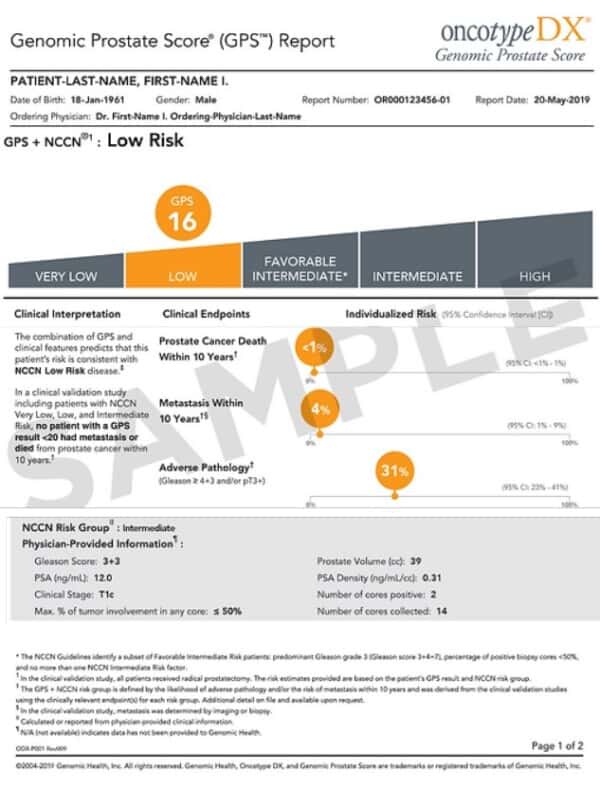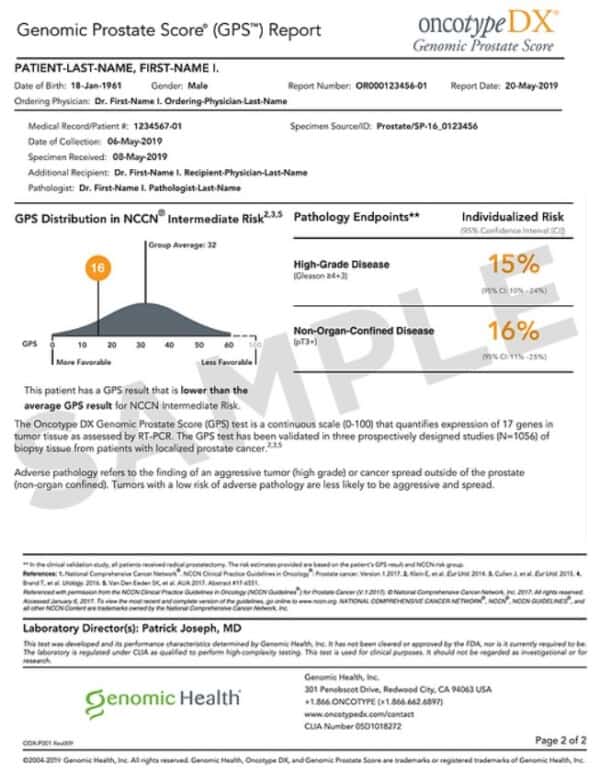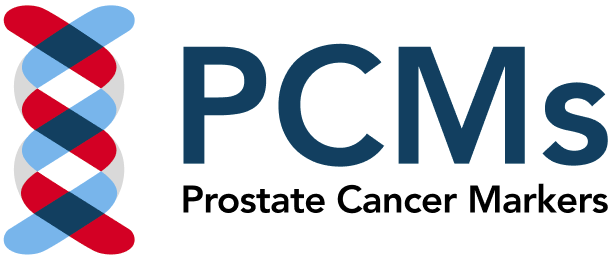AR-V7 results mean?
The purpose of this test is to identify mCRPC (metastatic castration-resistant prostate cancer) patients who will NOT respond to androgen receptor (AR) targeted therapies, such as abiraterone and enzalutamide, and should therefore consider chemotherapy.
Over time, tumors can adapt (and become resistant) to AR-targeted treatments. AR-V7 Nucleus Detect is designed to detect AR-V7 proteins in the nucleus of circulating tumor cells (CTCs) in the blood. Large clinical studies found that AR-V7+ patients (patients with AR-V7 in the nucleus of CTCs) do not benefit from AR-targeted therapies, experience faster progression and lower median overall survival (compared with patients negative for AR-V7), and are substantially more likely to live longer when treated with taxane chemotherapy (1, 2). The sample is obtained through a blood draw.
Patient Sample Report
This page contains a patient sample report with information on what each section means.

GPS + NCCN Individualized Risk :
By combining the Oncotype DX Genomic Prostate Score® (GPS) result with your NCCN Risk Score, the report provides clear risk stratification. The Genomic Prostate Score (GPS) is calculated by using a specialized lab test (called reverse-transcriptase polymerase chain reaction or RT-PCR) to analyze 17 different genes in your prostate tissue. The score is complied by determining which of these genes or combinations of genes are active, and which are inactive and this is compared to your NCCN Risk. The score ranges from 0-100 (with scores closer to zero representing lower risk prostate cancer disease potential and those closer to 100 representing higher risk prostate cancer disease potential. In this case, this patient had a specific combination of genes, on his OncotypeDx results, which were activated or deactivated. That made his overall risk (GPS+NCCN, according to the validation study) to be lower than the NCCN (low risk) score alone.
Prostate Cancer Prognosis:
This section predicts 10-year clinical risk of prostate cancer death and metastasis. In this example, the patient has less than a 1% chance of prostate cancer death within 10 years and a 4% chance of metastasis within 10 years.
Adverse Pathology – tumor aggressiveness:
This section predicts the patient’s likelihood of adverse pathology (Gleason ≥ 4+3 and/or pT3+). In this example, there is a 31% likelihood of adverse pathology. This section describes how your individualized risk score, which can range from 100% (less favorable, higher risk) to 0% (more favorable, lower risk). The 95% confidence interval (CI) shown at the end of each chart (in this case, the 95% CI is 23%-41%) means that 95% of patients in a similar GPS+NCCN Risk Category fell between 23% and 41% for having adverse pathology.
Clinical Information:
This section describes results from your blood tests, prostate pathology result, and your clinical stage. It is with this information that your health care provider is able to categorize your National Comprehensive Cancer Network (NCCN) Risk category as very low, low, or intermediate risk.

GPS Distribution Percentile:
This section describes your approximate risk category compared to other people in the same NCCN risk profile. Thus, in this example with a GPS score of 12 (the group average of people in the NCCN low risk category had a GPS of 25), this patient’s relative risk found on their OncotypeDx report is significantly lower than the average risk that was found in a group of men who took part in the validation study who fit into a similar NCCN low risk category.
Pathology Risk:
This section describes several different percentage categories that predict your risk of having a higher-grade cancer hiding in your prostate, as well as the likelihood that your disease is only low grade. The likelihood of favorable pathology represents an individual’s chance of having both organ confined disease, as well as what OncotypeDx considers low grade disease (less than or equal to Gleason 7, 3+4). These low-risk features are then broken down in the subsequent categories. Results closer to 0% offer more favorable results, whereas results closer to 100% offer less favorable (higher risk) results. In parentheses, you will notice what is described as a 95% confidence interval (95% CI). This is a statistical calculation which depicts the approximate percentage spread (lowest percent, highest percent) of 95% of the individuals who had similar combined NCCN + GPS scores.
Since prostate cancer is often a disease that occurs in more than one area, the GPS score looks at activated genes that were present in your positive biopsy, and is able to calculate the likelihood of these three factors based on which genes were activated on your cancer. The results of this section may help you and your health care provider decide if active surveillance is an appropriate option, or if further biopsies and/or definitive treatment may be necessary.
